Many species of vines grow and thrive in the shade. They have gracefully adapted to the interplay of light and shadow and emerge with incredible foliage and often flowers. Each vine tells a story of resilience and harmony, embodying the delicate equilibrium that characterizes the natural world. Our list consists of 25 species of vines that grow and thrive in the shade, though countless more species of vines are not included on our list that also thrive in shady conditions.
Overview of 25 Vines that Grow and Thrive in the Shade
| Species | Scientific Name |
|---|---|
| Blue China Vine | Holboellia coriacea |
| Late Dutch Honeysuckle | Lonicera periclymenum ‘Serotina’ |
| Bleeding Heart Vine | Clerodendrum thomsoniae |
| Broad-Leaved Sweet Pea | Lathyrus latifolius |
| Butterfly Vine | Mascagnia macroptera |
| Virginia Creeper | Parthenocissus quinquefolia |
| Boston Ivy | Parthenocissus tricuspidata |
| Climbing Hydrangea | Hydrangea petiolaris subsp. petiolaris |
| Trumpet Vine | Campsis radicans |
| Butterfly Pea | Clitoria ternatea |
| Old Man’s Beard | Clematis vitalba |
| Blue Trumpet Vine | Thunbergia grandiflora |
| Japanese Hydrangea Vine | Schizophragma hydrangeoides |
| Chinese Wisteria | Wisteria sinensis |
| Periwinkle | Vinca minor |
| Emerald Gaiety Euonymus | Euonymus fortunei ‘Emerald Gaity’ |
| Japanese Honeysuckle | Lonicera japonica ‘Halliana’ |
| Clematis | Clematis montana or Clematis alpina |
| Sweet Autumn Clematis | Clematis paniculata or Clematis terniflora |
| English Ivy | Hedera helix |
| Chocolate Vine | Akebia quinata |
| Crimson Glory Vine | Vitis coignetiae |
| Kadsura Vine | Kadsura japonica |
| Variegated Kiwi Vine | Actinidia kolomikta |
| Golden Pothos | Epipremnum aureum |
25 Vines that Grow and Thrive in the Shade
1. Blue China Vine (Stauntonia coriacea)
First on our list of vines that grow and thrive in the shade is Blue China Vine. The scientific name of Blue China Vine is Stauntonia coriacea. This evergreen climber thrives in USDA Hardiness Zones 8 to 11, prefers moist soil, and can attain heights of up to 23 feet. It is native to East Asia and is tolerant of both sunlit spaces and fully shaded areas. Amid palmate leaves, delicate flowers of cream to dusky mauve in color imbue the air with a sweet scent during the balmy embrace of spring.

Blue China Vine, or
Stauntonia coriacea, is an evergreen vine that thrives in USDA Hardiness Zones 8 to 11.
©igaguri_1/ via Getty Images
2. Late Dutch Honeysuckle (Lonicera periclymenum ‘Serotina’)
The scientific name of Late Dutch Honeysuckle is Lonicera periclymenum ‘Serotina.’ With a slow growth pattern, this deciduous vine extends 12 to 20 feet in height. Its tubular crimson blooms, adorned with creamy-yellow insides, contrast strikingly against the backdrop of dark green oval leaves. Moreover, it is native to Europe, North Africa, and western Asia.
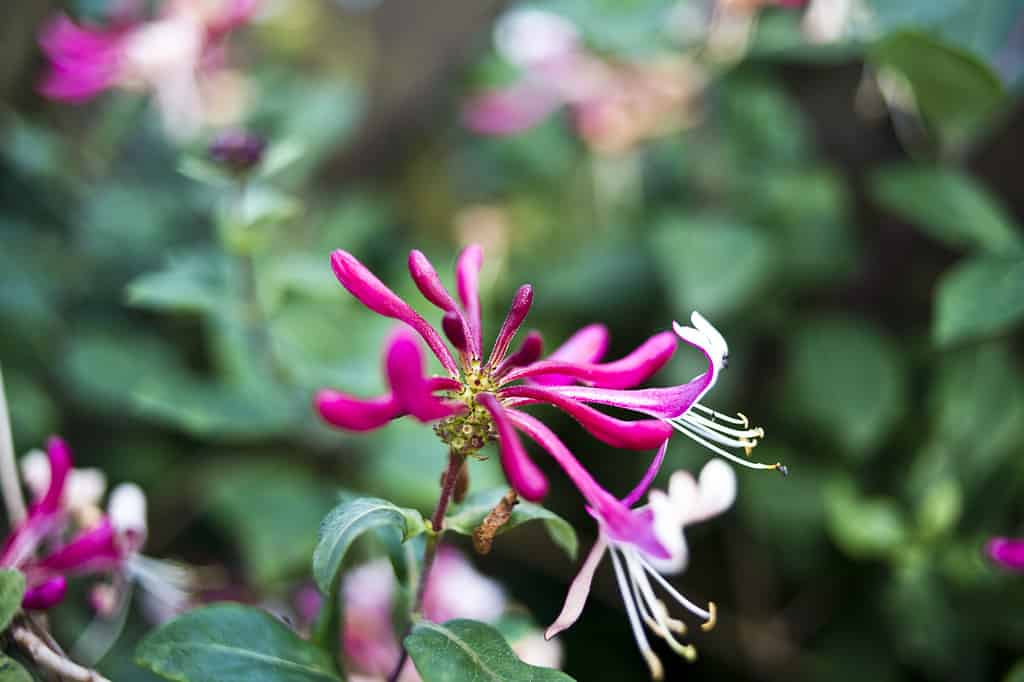
Late Dutch Honeysuckle, or
Lonicera periclymenum‘Serotina,’ is a deciduous vine that can extend 12 to 20 feet in height.
©Kamila Kozioł/ via Getty Images
3. Bleeding Heart Vine (Clerodendrum thomsoniae)
The scientific name of Bleeding Heart Vine is Clerodendrum thomsoniae. It flourishes without heed to the intensity of sunlight. Thriving in USDA Hardiness Zones 10 to 12, it prefers dappled or partial shade. Furthermore, this flowering vine emanates a sense of elegance with its pendulous, white calyces with dark red corolla and lush foliage.
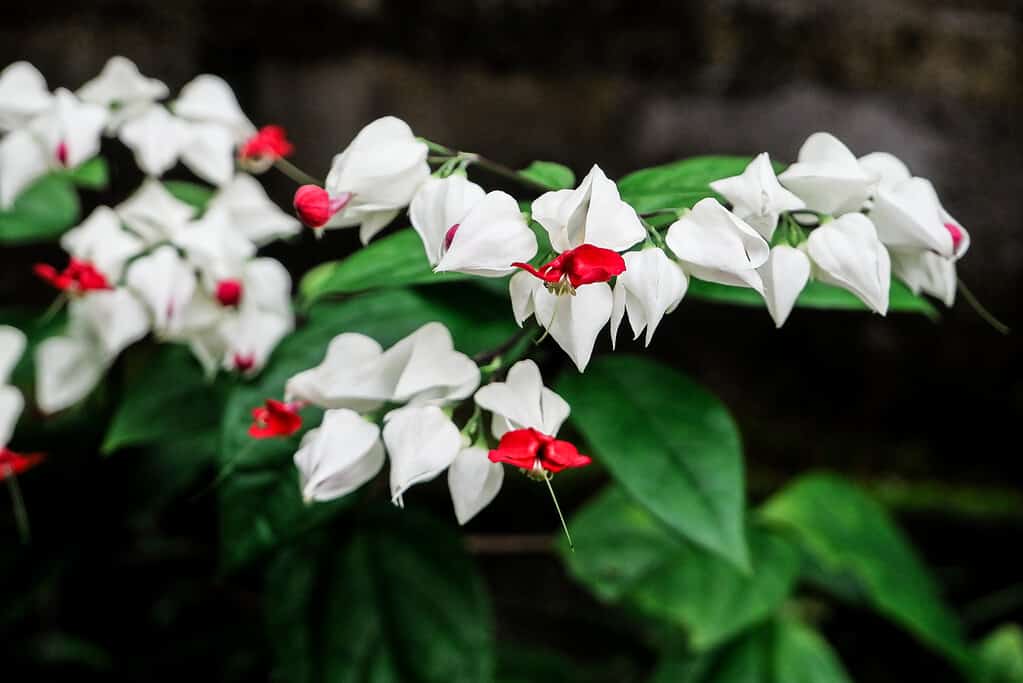
Bleeding Heart Vine, or
Clerodendrum thomsoniae, thrives in USDA Hardiness Zones 10 to 12 and prefers dappled or partial shade.
©HAS/ via Getty Images
4. Broad-leaved Sweet Pea (Lathyrus latifolius)
The Broad-leaved Sweet Pea, Lathyrus latifolius, can grow up to 9 feet in height. Flourishing under partial shade or full sun, this herbaceous perennial flowering plant showcases a symphony of flowers blooming from June through July in shades that range from blushing pinks to regal purples, pristine whites, and passionate reds. Furthermore, it is native to the Mediterranean.
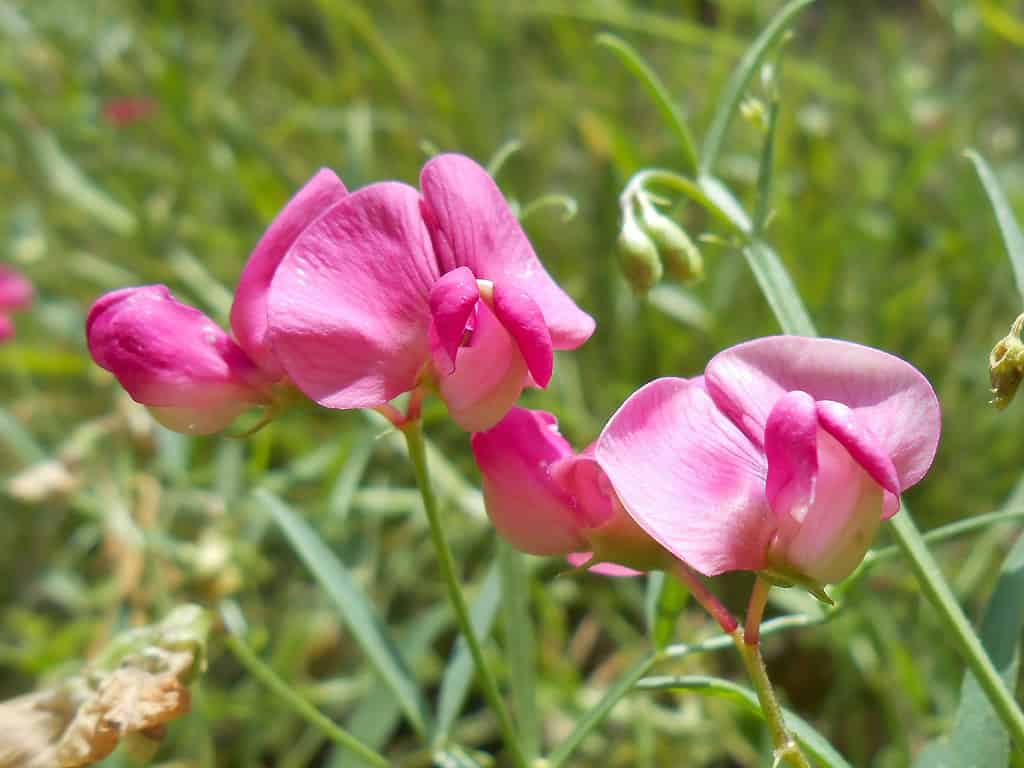
Broad-leaved Sweet Pea, or
Lathyrus latifolius, grows under partial shade or full sun. It blooms from June through July in colors that range from blushing pinks to vivid purples, whites, and reds.
©Carlos Menes Isiegas/ via Getty Images
5. Butterfly Vine (Mascagnia macroptera)
The scientific name of Butterfly Vine is Mascagnia macroptera. This heat-loving evergreen vine can grow up to 12 feet in height. It produces yellow, orchid-shaped flowers that alight like fluttering wings. This swift-growing climber paints the canvas of its surroundings with vibrant life as its sunny flowers transition to earthy tones of brown amongst dark green foliage, mirroring the cycles of nature. Moreover, it thrives in USDA Hardiness Zones 8 to 10.
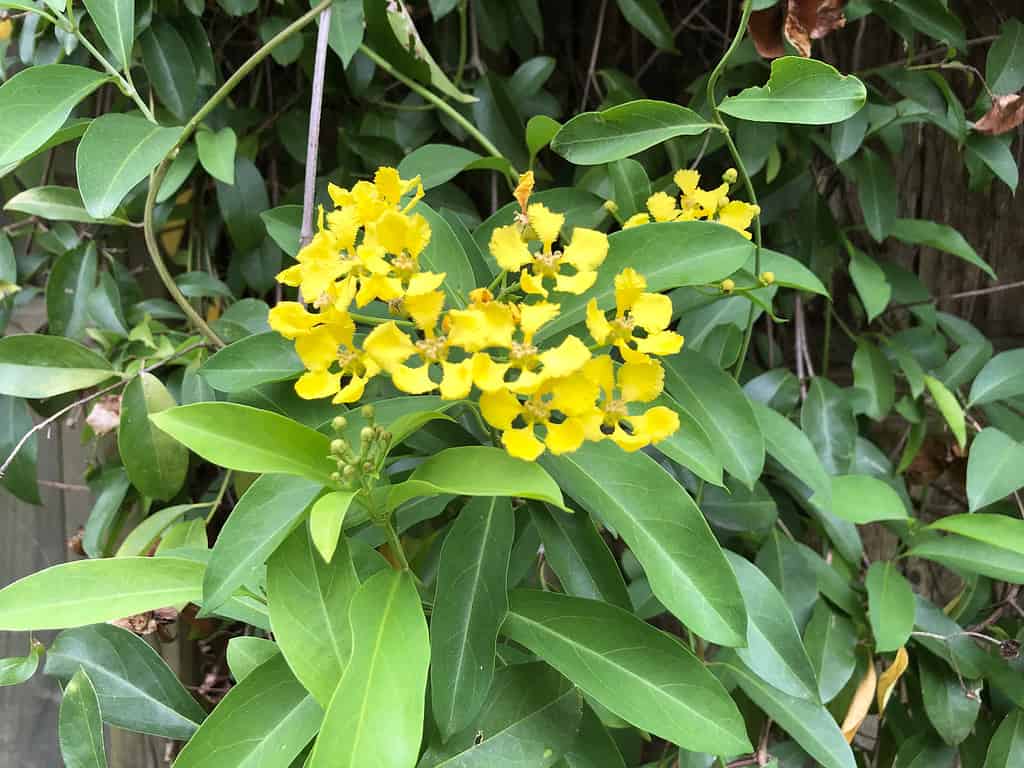
Butterfly Vine, or
Mascagnia macroptera, is a heat-loving evergreen vine that can grow up to 12 feet in high.
©Campwillowlake/ via Getty Images
6. Virginia Creeper (Parthenocissus quinquefolia)
The scientific name of Virginia Creeper is Parthenocissus quinquefolia. This vine is easy to grow and incredibly adaptable. It thrives in USDA Hardiness Zones 3 to 9. With its greenish-white blossoms, it thrives under full sun or the cool embrace of partial shade. Moreover, from sandy to clay and loamy soils, it draws sustenance, its tendrils reaching out, stretching to heights of 30 to 50 feet. A versatile companion, it paints arboreal landscapes with its vibrant foliage.

Virginia Creeper, or
Parthenocissus quinquefolia, grows in USDA Hardiness Zones 3 to 9 and thrives under full sun or partial shade. It can reach heights of 30 to 50 feet.
©tataks/ via Getty Images
7. Boston Ivy (Parthenocissus tricuspidata)
Next on our list of vines that grow and thrive in the shade is Boston Ivy. Boston Ivy, Parthenocissus tricuspidata, is native to China and Japan. This deciduous, woody vine thrives in USDA Hardiness Zones 4 to 8 and prefers full sun, partial shade, or full shade. It also has a preference for loamy soils. It can grow to incredible heights of 30 to 50 feet. Moreover, as seasons waltz, its leaves transform into a kaleidoscope of colors consisting of reds and purples, revealing the symphony of change that reverberates through nature’s embrace.
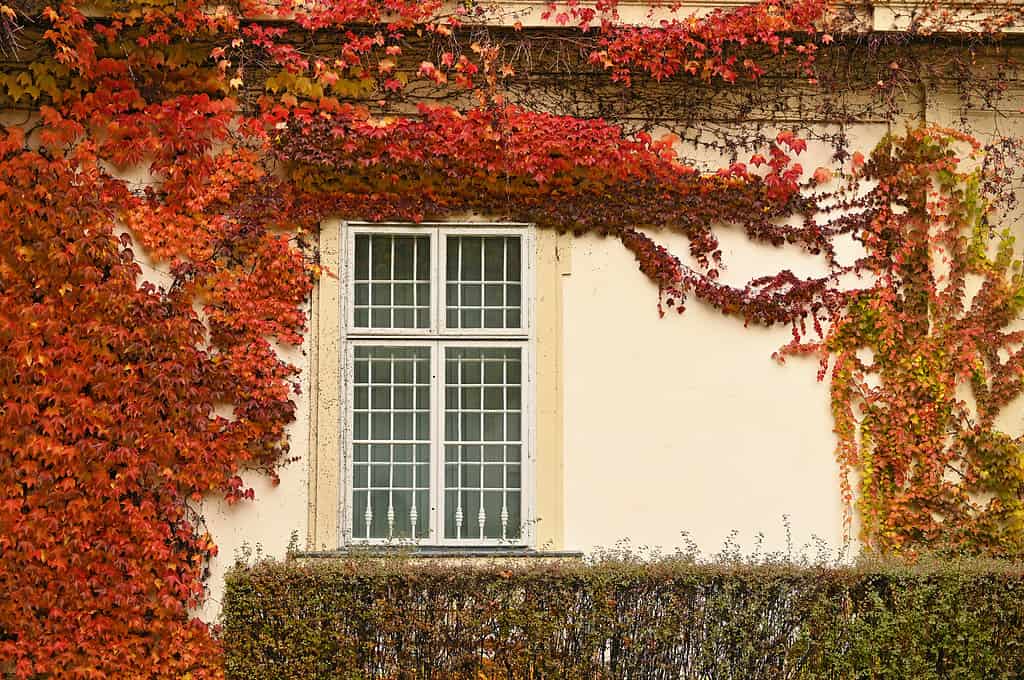
Despite its common name, Boston Ivy, or
Parthenocissus tricuspidata, is native to
China
and
Japan
. This woody vine can thrive in full sun, partial shade, or full shade.
©goce/ via Getty Images
8. Climbing Hydrangea (Hydrangea petiolaris subsp. petiolaris)
Amongst the shades, the Climbing Hydrangea, Hydrangea petiolaris subsp. petiolaris, unfurls its petals, a spectacle of creamy white to greenish-yellow to stark white against dark, ovate green leaves. It prefers partial shade or full shade as well as moist but well-drained soil. Moreover, with elegance, it ascends to heights of 30 to 50 feet, spanning 5 to 6 feet wide. Its blooms embody the subtle grace of nature.
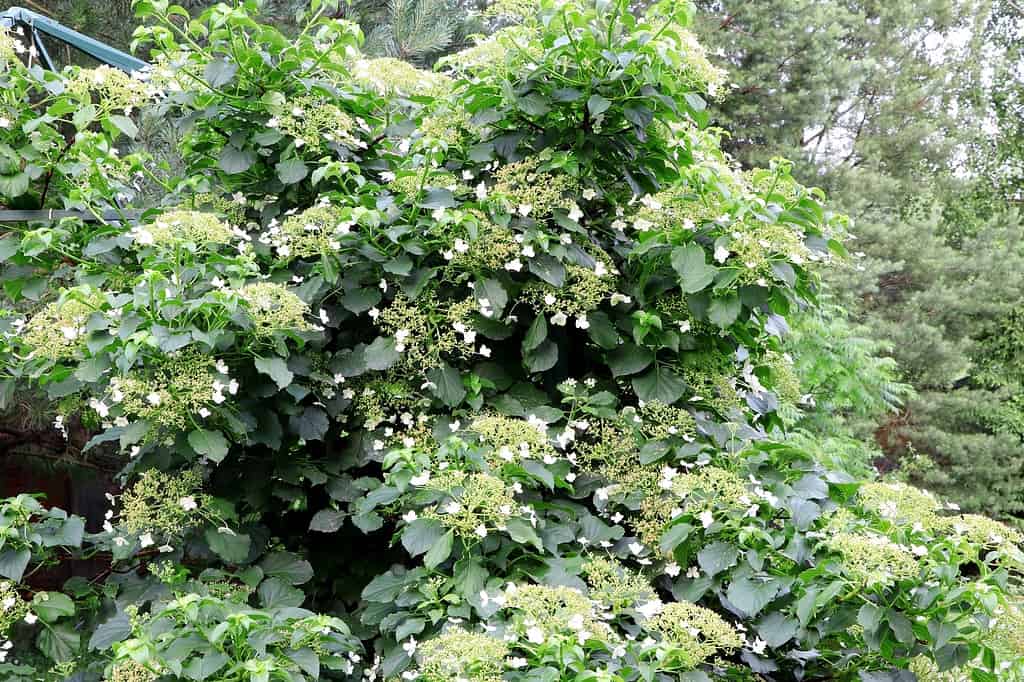
Climbing Hydrangea, or
Hydrangea petiolarissubsp.
petiolaris, can grow to heights of 30 to 50 feet and span 5 to 6 feet wide.
©Mikhail Kolomiets/ via Getty Images
9. Trumpet Vine (Campsis radicans)
The Trumpet Vine, Campsis radicans, is native to the southeastern United States. Its blooms are predominantly orange and red blooms, and it flourishes under partial shade or full sun. Moreover, it is considered high-maintenance and thrives in USDA Hardiness Zones 4 to 9. With ambition, it can stretch 25 to 40 feet in height, spanning 5 to 10 feet wide. This vine is also highly attractive to hummingbirds.
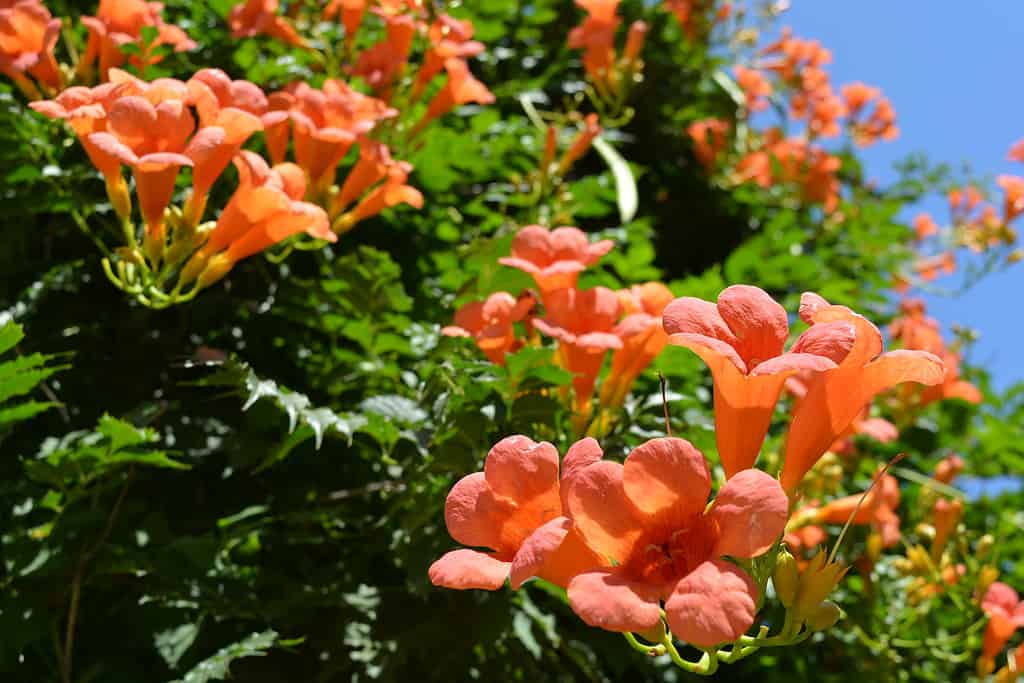
Trumpet Vine, or
Campsis radicans, has blooms that are predominantly orange and red blooms. It flourishes under partial shade.
©Daria Katiukha/ via Getty Images
10. Butterfly Pea (Clitoria ternatea)
The Butterfly Pea, Clitoria ternatea, is native to tropical regions in Asia and Africa. As its name suggests, it blossoms with delicate petals that are bluish-purple and yellow towards the center, symbolizing feminine beauty. It can grow to heights of 10 to 15 feet and widths of 3 to 6 feet. It prefers full sun but can thrive in partial shade. Furthermore, this vine grows best in USDA Hardiness Zones 11 to 12.
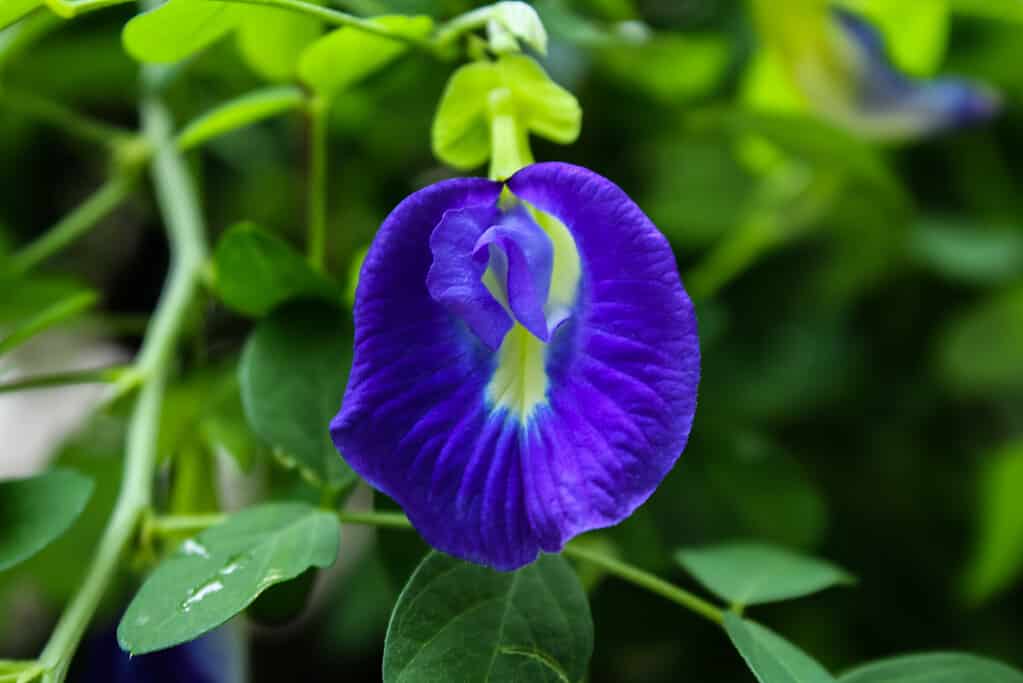
Butterfly Pea, or
Clitoria ternatea, has delicate blossoms that are bluish-purple and yellow towards the center, symbolizing feminine beauty.
©Eny Purwanti/ via Getty Images
11. Old Man’s Beard (Clematis vitalba)
The scientific name of Old Man’s Beard is Clematis vitalba. This deciduous climber can grow upwards of 50 feet in height. It has a preference for partial shade or full sun. Interestingly, though all parts of this vine are poisonous, they can be prepared for various edible and medicinal purposes. Its whitish-green flowers release sweet fragrances, drawing you closer. A master of adaptation, it finds footing in various habitats, with its tendrils winding upward.

Old Man’s Beard, or
Clematis vitalba, can grow upwards of 50 feet in height.
©aga7ta/ via Getty Images
12. Blue Trumpet Vine (Thunbergia grandiflora)
The Blue Trumpet Vine, Thunbergia grandiflora, is native to tropical regions of southeastern Asia. Pale, creamy yellow and lavender-blue blooms cascade like liquid sunshine. It can reach heights of 15 to 30 feet and widths of 3 to 6 feet. Furthermore, this vine prefers partial shade to full sun. While it is predominantly low maintenance, it requires medium watering and blooms from August to September.
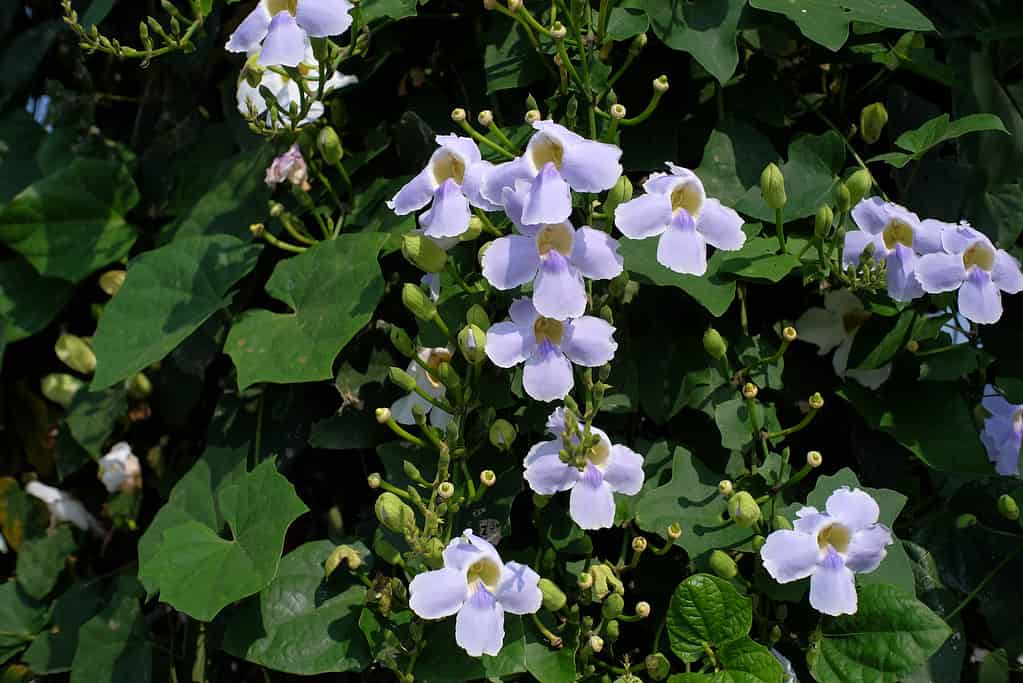
Blue Trumpet Vine
,or
Thunbergia grandiflora, can reach heights of 15 to 30 feet and widths of 3 to 6 feet.
©bari paramarta/ via Getty Images
13. Japanese Hydrangea Vine (Schizophragma hydrangeoides)
The Japanese Hydrangea Vine, Schizophragma hydrangeoides, is native to Japan and Korea and thrives in USDA Hardiness Zones 5 to 8. Its dark green, heart-shaped foliage provides a backdrop for creamy white lace cap flowers that bloom from June to July. This vine grows from 20 to 30 feet in height, while it reaches widths of 6 to 9 feet. It has a preference for full shade or partial shade, in addition to well-drained soil with consistent watering.

Japanese Hydrangea Vine is native to Japan and Korea and thrives in USDA Hardiness Zones 5 to 8.
©ziggy_mars/ via Getty Images
14. Chinese Wisteria (Wisteria sinensis)
The scientific name of Chinese Wisteria is Wisteria sinensis. This vine is native to China and is considered a noxious weed in multiple Midwestern states. Its blooms, violet-blue in color, evoke a sense of wonder. It grows to heights of 10 to 25 feet and widths of 4 to 8. It is high maintenance and requires consistent watering. Furthermore, this vine has a preference for partial shade to full sun and thrives in USDA Hardiness Zones 5 to 8.

Chinese Wisteria, or
Wisteria sinensis, is a vine that is native to China and has violet-blue blooms that can grow to heights of 10 to 25 feet and widths of 4 to 8.
©romrodinka/ via Getty Images
15. Periwinkle (Vinca minor)
Preferring partial shade, Common Periwinkle, Vinca minor, unfolds its tapestry of color. Its blossoms, ranging from light bluish-lavender to light purple and white, grace the world with delicate elegance. This herbaceous perennial is native to Europe and southern Russia. It has a preference for dry to moderately wet soil. It can thrive within diverse environments across USDA Hardiness Zones 4 to 8. Periwinkle can grow up to 6 feet tall, creating a lush carpet of floral beauty that thrives beneath the dappled canopy. Moreover, with evergreen leaves and showy flowers, this flower makes a beautiful addition to any garden or landscape.
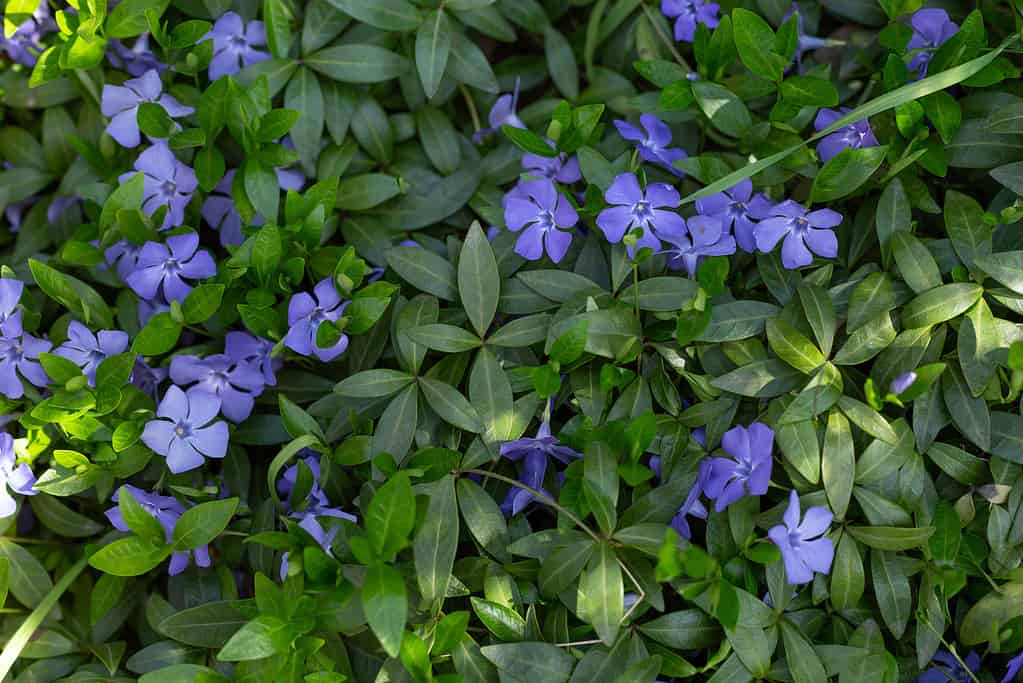
Periwinkle, or
Vinca minor, is a herbaceous perennial that is native to Europe and southern Russia.
©Kebal Aleksandra/ via Getty Images
16. Emerald Gaiety Euonymus (Euonymus fortunei ‘Emerald Gaity’)
Emerald Gaiety Euonymus, known by its scientific name Euonymus fortunei ‘Emerald Gaity,’ is native to East Asia. This broadleaf evergreen to semi-evergreen subshrub can climb using adventitious roots. Its variegated leaves, a symphony of green to white, offer a visual delight. Moreover, it can flourish in full shade, partial shade, or even full sun in full sun. On average, it grows to heights of 3 to 5 feet and widths of 3 to 6 feet, gracing the landscapes with its restrained elegance. It grows best in USDA Hardiness Zones 5 to 8.
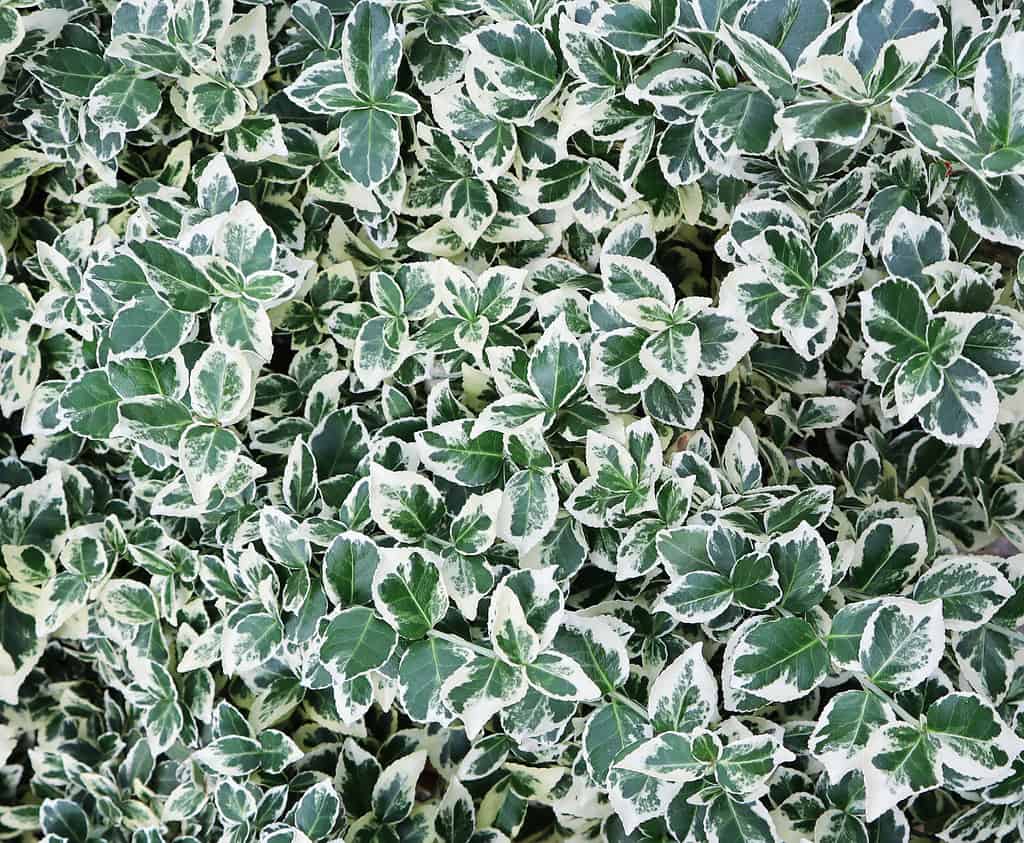
Emerald Gaiety Euonymus, or
Euonymus fortunei‘Emerald Gaity,’ can flourish in full shade, partial shade, or even full sun in full sun.
©Volha Halkouskaya/ via Getty Images
17. Japanese Honeysuckle (Lonicera japonica ‘Halliana’)
Another plant on our list of vines that grow and thrive in the shade is Japanese Honeysuckle. The scientific name of Japanese Honeysuckle is Lonicera japonica ‘Halliana’. This vine is tolerant of drought and thrives in partial shade to full sun, casting its enchanting fragrance into the air. Its white and yellow blooms stand as a beacon of life’s vibrancy. Tolerant of diverse soil conditions, it can reach heights of 15 to 30 feet and widths of 3 to 6 feet. Moreover, its tendrils weave stories of growth and tenacity. Incredibly showy and fragrant, it thrives in USDA Hardiness Zones 4 to 9 and is highly attractive to hummingbirds and butterflies.

Japanese Honeysuckle,
Lonicera japonica‘Halliana,’ is tolerant of drought and can thrive in partial shade.
©Ellita/ via Getty Images
18. Clematis (Clematis montana or Clematis alpina)
In the realm of Clematis, Clematis montana and Clematis alpina prefer partial shade. Clematis montana produces whitish-yellow flowers and grows up to 40 feet in height. In comparison, Clematis alpina produces deep purple flowers and grows up to 12 feet in height. Furthermore, their blooms paint the canvas of their surroundings with beauty. Both are low maintenance and require medium watering. They are equally showy and bring beauty wherever they grow.
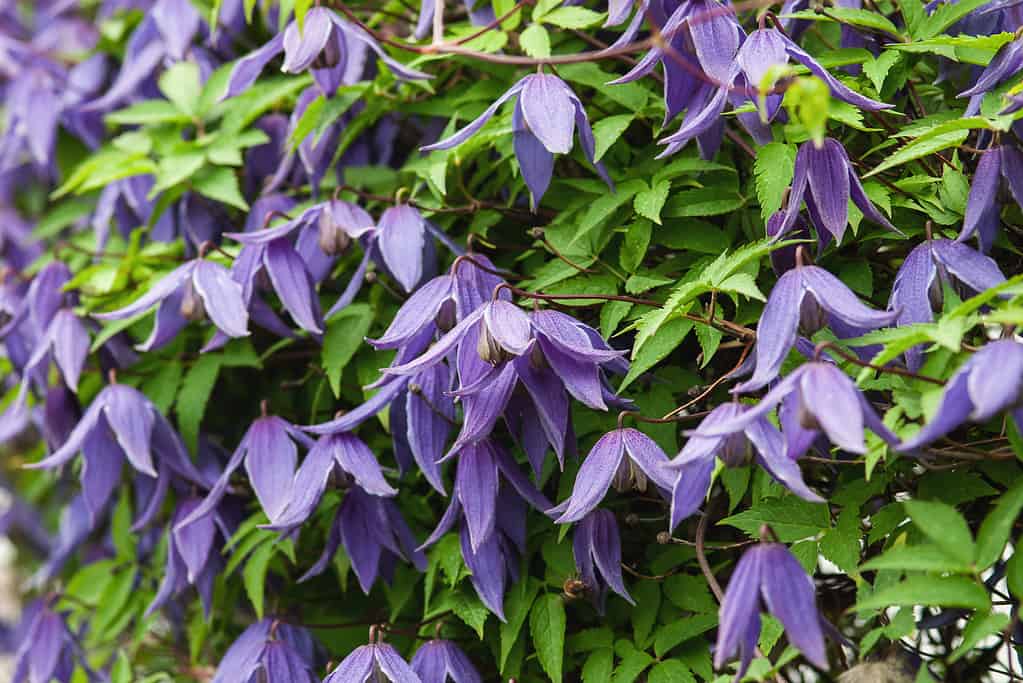
grows up to 12 feet in height and produces deep purple flowers.
©Nadya So/ via Getty Images
19. Sweet Autumn Clematis (Clematis paniculata or Clematis terniflora)
Clematis paniculata is native to New Zealand, while Clematis terniflora is native to northeastern Asia. Both varieties thrive in shady conditions compared to other Sweet Autumn Clematis varieties and grace the landscape with white blooms. Thriving in well-drained soil, they can ascend to heights of 10 to 30 feet. Furthermore, both varieties produce flowers that are petite and white.
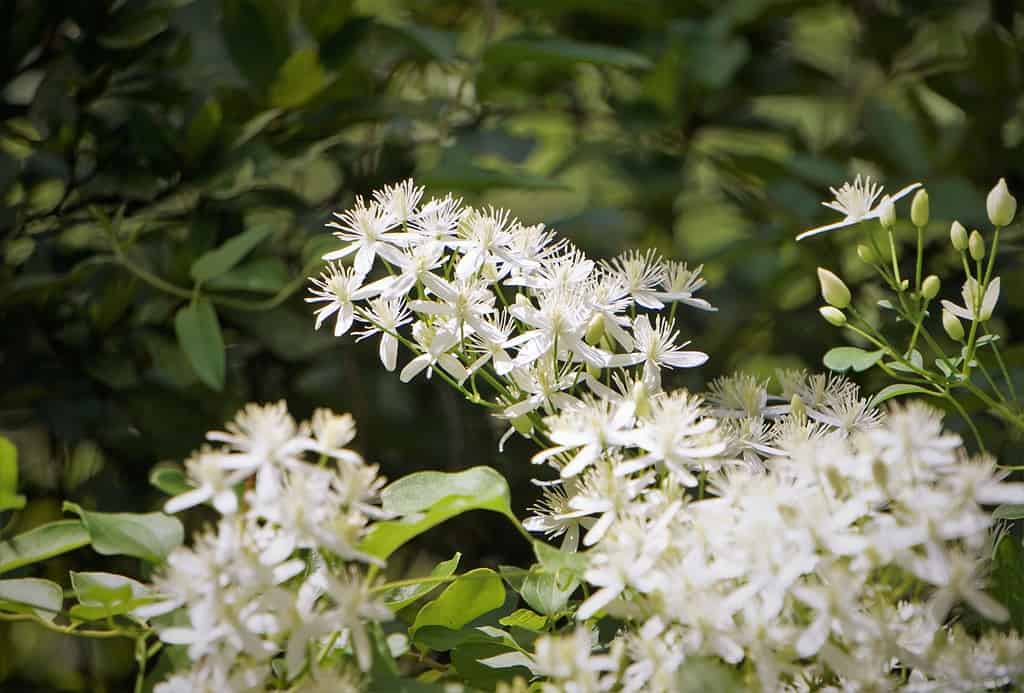
, a variety of Sweet Autumn Clematis, is native to northeastern Asia.
©ANCHASA MITCHELL/ via Getty Images
20. English Ivy (Hedera helix)
The scientific name of English Ivy is Hedera helix. It is native to Europe, Scandinavia, and Russia. This vine can grow to incredible heights of 20 to 80 feet and widths of 3 to 50 feet. English Ivy thrives in USDA Hardiness Zones 4 to 9. However, it can be weedy and is considered invasive in multiple Midwestern states. Its greenish-white blooms appear from September through October. Furthermore, its ability to climb and spread knows no bounds, embodying nature’s vitality. Furthermore, this evergreen vine is low maintenance and requires medium watering. With a preference for moist, fertile, neutral to alkaline soil, it thrives within the interplay of light and shadow.
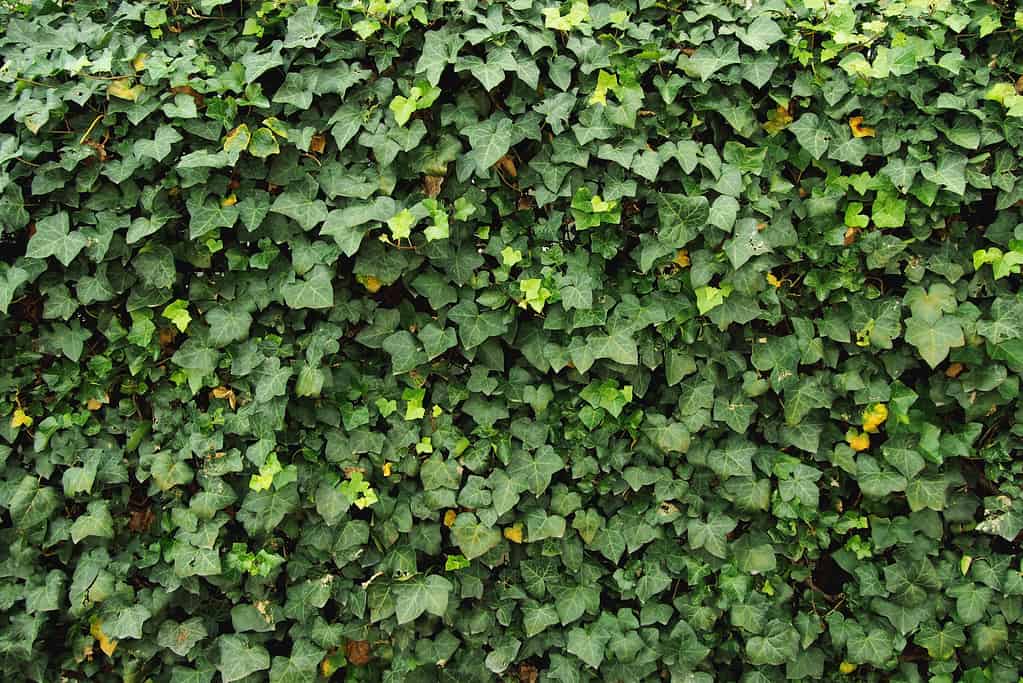
English Ivy is native to Europe, Scandinavia, and Russia.
©Yue_/ via Getty Images
21. Chocolate Vine (Akebia quinata)
Chocolate Vine, or Akebia quinata, is native to Japan, China, and Korea. It thrives in USDA Hardiness Zones 4 to 8 but is considered a noxious weed in multiple states in the Midwest. Its blooms, ranging from chocolate to purple, offer a palette of colors and appear from March to April. This showy and fragrant vine stretches to heights of 20 to 40 feet, while its width spans 6 to 9 feet. This vine prefers conditions with more sun but can easily tolerate full shade.
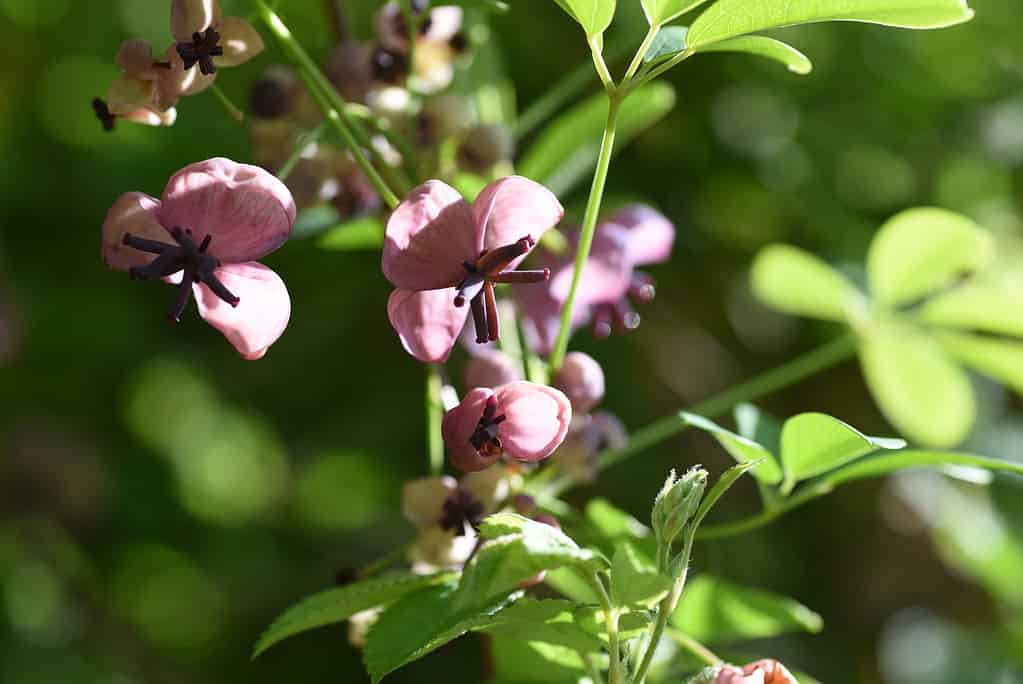
Chocolate Vine thrives in USDA Hardiness Zones 4 to 8 but is considered a noxious weed in multiple Midwestern states.
©undefined undefined/ via Getty Images
22. Crimson Glory Vine (Vitis coignetiae)
Crimson Glory Vine, or Vitis coignetiae, is native to Japan and thrives in USDA Hardiness Zones 5 to 9. It can reach heights of 30 to 60 feet and widths of 20 to 30 feet. With an innate swiftness, it climbs towards the sky, its heart-shaped green leaves a verdant tapestry that transforms come autumn. As the seasons wane, these leaves burst into scarlet, orange, and crimson hues, painting the landscape with the fire of autumn’s embrace. This vine thrives in well-drained soil, partial shade, or full sun. It is also tolerant of heat, cold, and wind.
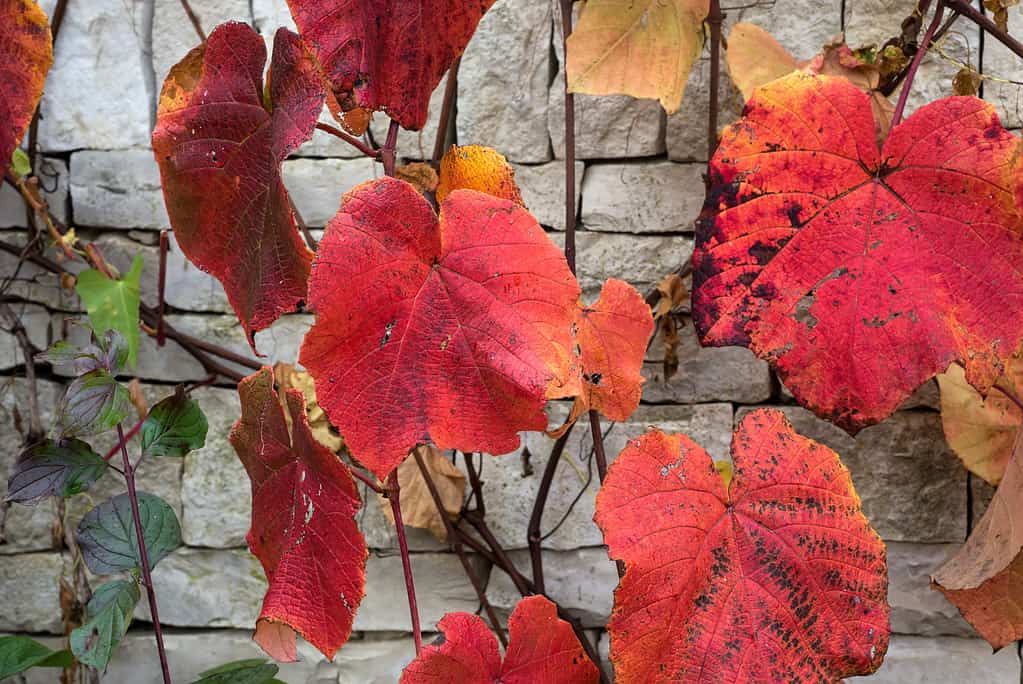
Crimson Glory Vine can reach heights of 30 to 60 feet and widths of 20 to 30 feet.
©Neydtstock/ via Getty Images
23. Kadsura Vine (Kadsura japonica)
The scientific name of Kadsura Vine is Kadsura japonica. This evergreen climber is native to Japan and flourishes in UDSA Hardiness Zones 6 to 9. Its delicate demeanor belies its resilience, thriving amidst partial shade to full sun. As spring unfurls, the vine dons yellow-to-white blooms, a fleeting symphony of beauty. Yet, the promise of red berries and dark green leaves draws admirers. Furthermore, this vine can grow up to 12 feet in height.
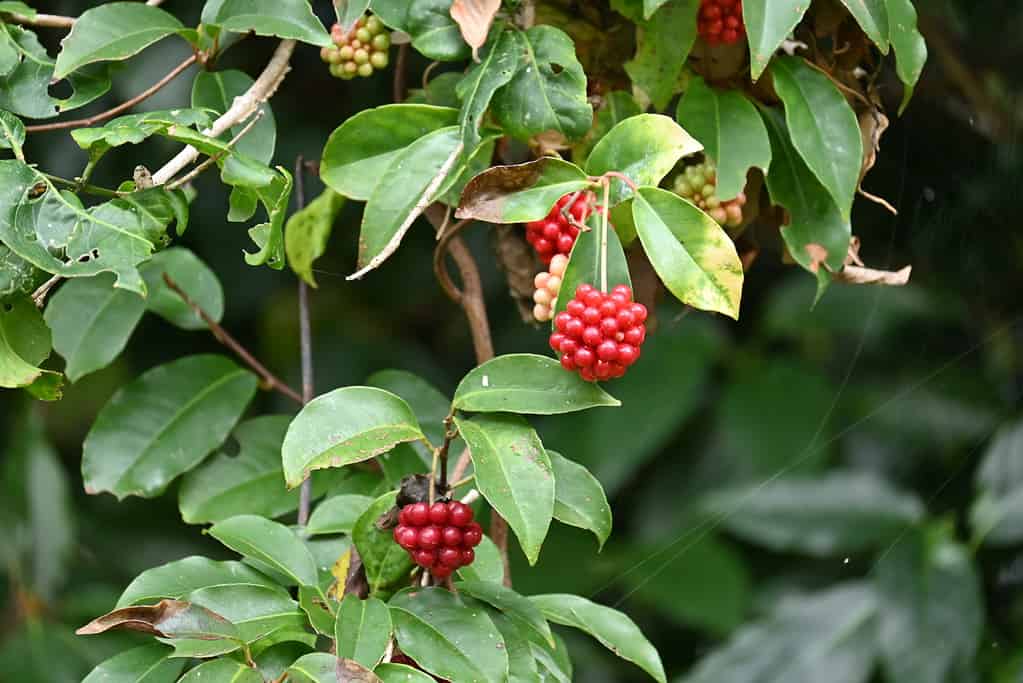
Kadsura Vine is native to Japan and flourishes in UDSA Hardiness Zones 6 to 9
©undefined undefined/ via Getty Images
24. Variegated Kiwi Vine (Actinidia kolomikta)
Variegated Kiwi Vine, or Actinidia kolomikta, is native to temperate regions of eastern Asia. It can grow 15 to 20 feet in height and 6 to 10 feet in width. Spring brings forth delicate white blooms, a prelude to the verdant spectacle that follows. This fast-growing, deciduous, woody vine draws the eye and imagination and thrives in USDA Hardiness Zones 4 to 8. Furthermore, its fruit is edible and appears in the fall. While it prefers partial shade to full sun, it is a low-maintenance vine that requires moderate watering.
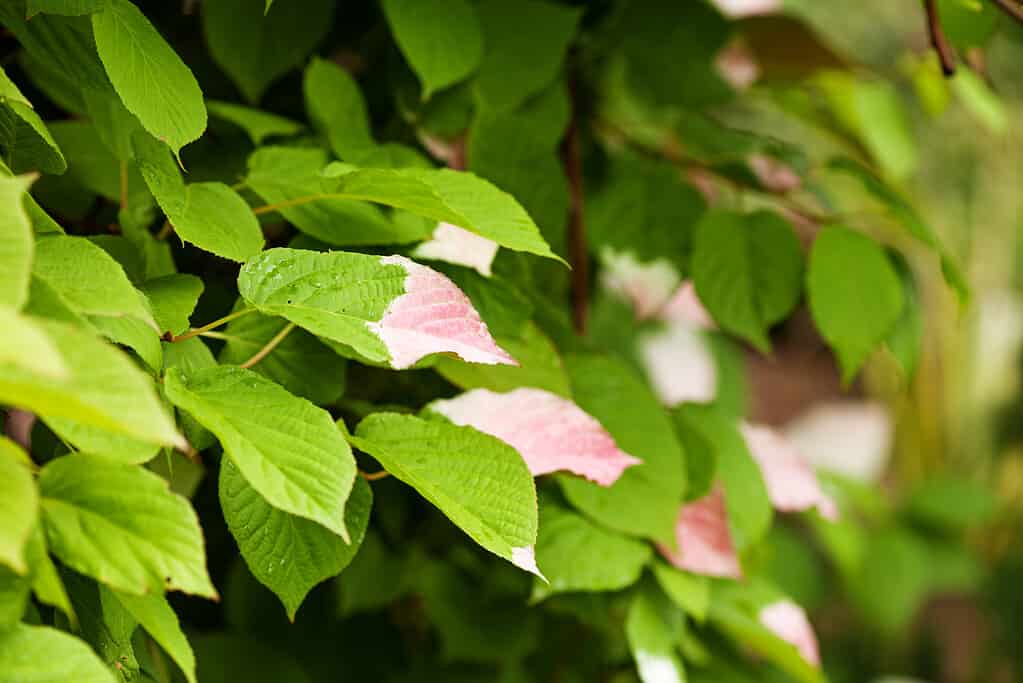
Variegated Kiwi Vine can grow 15 to 20 feet in height and 6 to 10 feet in width.
©speakingtomato/ via Getty Images
25. Golden Pothos (Epipremnum aureum)
Last on our list of vines that grow and thrive in the shade is Golden Pothos. The scientific name of Golden Pothos is Epipremnum aureum. It is native to the Solomon Islands and grows best in USDA Hardiness Zones 10 to 12. It has heart-shaped, lush green leaves. On rare occurrences, it even flowers. Its growth knows no bounds, ascending to heights of 20 to 40 feet and widths of 3 to 6 feet. Furthermore, this plant is incredibly showy, requires medium watering, and prefers partial shade to full shade.
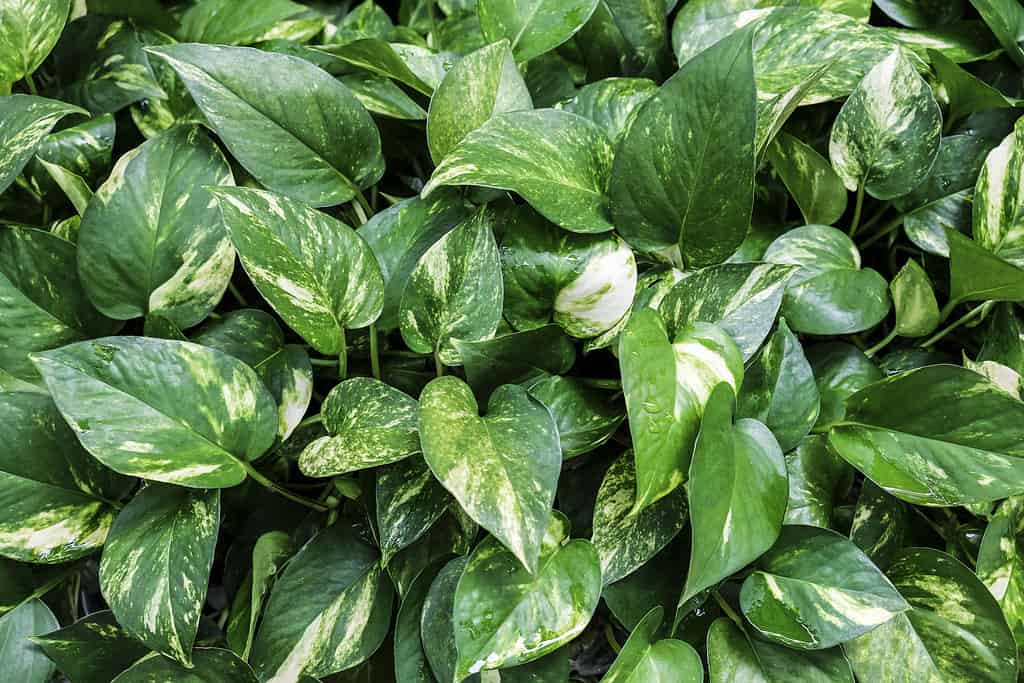
is the scientific name of Golden Pothos.
©FeelPic/ via Getty Images
The photo featured at the top of this post is © aga7ta/ via Getty Images
Thank you for reading! Have some feedback for us? Contact the AZ Animals editorial team.







